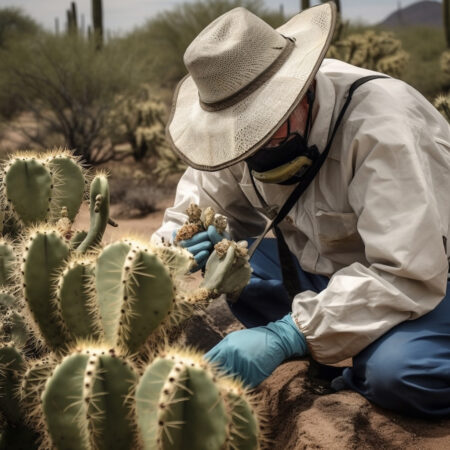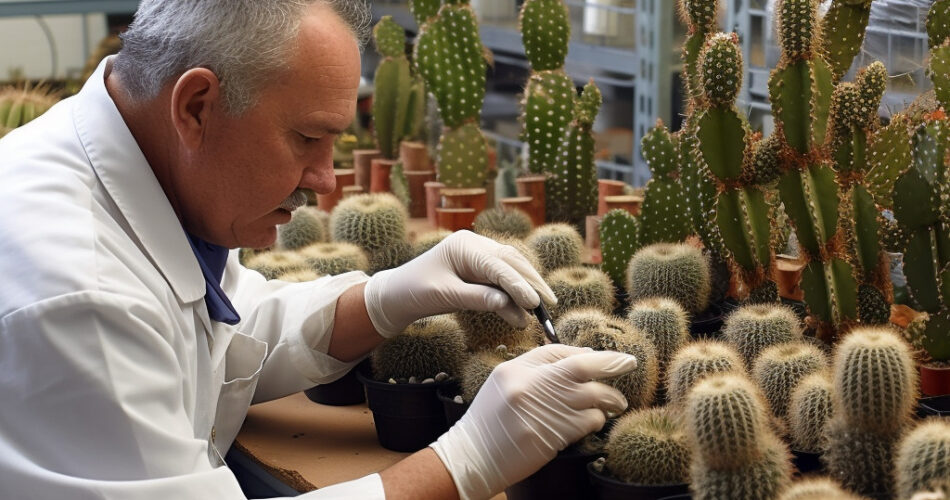Key Takeaways:
- Cactus diseases can have devastating effects on ecosystems and studying them is crucial for preserving biodiversity.
- Universities and research institutions play a key role in cactus disease research and environmental stewardship.
- Cutting-edge research techniques such as genetic analysis, nanotechnology, and data science are transforming cactus disease study.
- Collaboration among universities and research institutions is essential for addressing the challenges posed by cactus diseases.
- The future of cactus disease research holds promising breakthroughs and innovative solutions.
Why Studying Cactus Diseases is Crucial for the Environment
Cacti, with their unique ability to survive in harsh desert climates, play a vital role in maintaining the delicate balance of ecosystems. These resilient plants provide habitat and food for numerous species of insects, birds, and mammals. However, cactus diseases pose a significant threat to the survival of these plants and the biodiversity they support. Understanding and combating these diseases is essential for the preservation of our natural environment.
The Impact of Cactus Diseases on Ecosystems
Cactus diseases, caused by various pathogens such as bacteria, fungi, and viruses, can have devastating effects on ecosystems. They can lead to the death of cacti, resulting in habitat loss for many organisms that depend on these plants. Additionally, the decline in cactus populations can disrupt food chains and impact the overall balance of ecosystems. Therefore, studying cactus diseases is crucial for assessing the ecological impact and implementing necessary conservation measures.
Preserving Biodiversity Through Cactus Disease Research
Preserving biodiversity is a key pillar of environmental stewardship. Cacti are an integral part of arid and semi-arid ecosystems, serving as keystone species in these regions. By studying cactus diseases, scientists can gain insights into the underlying causes and transmission mechanisms of these diseases. This knowledge can help in developing strategies to protect and conserve cacti, thus safeguarding biodiversity and maintaining the intricate web of life in these habitats.
The Role of Universities in Environmental Stewardship
Universities and research institutions play a pivotal role in advancing cactus disease research and environmental stewardship. These institutions provide the necessary infrastructure, funding, and expertise to carry out comprehensive studies on cactus diseases. Through their research efforts, universities contribute to the scientific understanding of these diseases, and their findings inform conservation agencies and policymakers.
Moreover, universities serve as hubs of knowledge and education, training the next generation of scientists and environmentalists. By offering courses and conducting research on cactus diseases, universities create a platform for students to explore this field and contribute to its advancement. Additionally, universities often collaborate with other research institutions, both locally and globally, to tackle complex environmental challenges collectively.
The Cutting-Edge Research Techniques Used in Cactus Disease Study
Cactus disease research has benefited greatly from advancements in scientific techniques and technology. These innovative approaches have revolutionized our understanding of cactus diseases and accelerated the development of effective prevention and management strategies.
Genetic Analysis: Unveiling the Secrets of Cactus Diseases
Genetic analysis techniques, such as DNA sequencing and genotyping, have played a crucial role in unraveling the secrets of cactus diseases. By comparing the genomes of disease-resistant and susceptible cacti, researchers can identify genes associated with disease resistance. This information can be used to develop molecular markers for breeding programs aimed at producing disease-tolerant cactus varieties.
Furthermore, genetic analysis helps in understanding the evolutionary history of cactus diseases and their interactions with their host plants. By studying the genetic diversity and population structure of pathogens, researchers can gain insights into the transmission dynamics and potential for future outbreaks.
Nanotechnology: Revolutionizing Cactus Disease Detection
Nanotechnology has emerged as a powerful tool in disease detection and monitoring. Scientists are exploring nanosensors and nanobiosystems to detect specific pathogens or disease symptoms in cacti in real-time. These nanodevices can detect even trace amounts of pathogens, enabling early intervention and containment of cactus diseases.
Furthermore, nanotechnology-based delivery systems are being investigated for targeted and controlled delivery of antimicrobial agents to combat cactus diseases. These nanoformulations increase the efficiency and effectiveness of treatments while minimizing their environmental impact.
Data Science and Machine Learning: Accelerating Cactus Disease Research
The increasing availability of big data in plant pathology has opened new avenues for cactus disease research. Data science and machine learning techniques are being employed to analyze vast amounts of data generated from field surveys, genetic sequencing, and remote sensing.
Using these tools, researchers can identify patterns, predict disease outbreaks, and assess the impact of environmental factors on disease development. Machine learning algorithms can aid in the development of early warning systems for cactus diseases, enabling timely intervention measures.

Collaborative Efforts: Universities and Research Institutions Joining Forces
Addressing the complex challenges posed by cactus diseases requires interdisciplinary approaches and collaboration among universities and research institutions. By pooling their expertise and resources, these institutions can make significant progress in understanding, combating, and preventing cactus diseases.
Interdisciplinary Approaches: Botanists, Geneticists, and Epidemiologists Unite
Cactus disease research often involves interdisciplinary collaborations, bringing together botanists, geneticists, epidemiologists, and other experts. Botanists provide valuable insights into cactus biology and disease symptoms, geneticists contribute their expertise in understanding the genetic basis of disease resistance, while epidemiologists study disease transmission patterns and dynamics.
This interdisciplinary approach allows researchers to tackle cactus diseases from multiple angles, fostering a comprehensive understanding of the complex interactions between pathogens, cacti, and the environment. It also opens doors for innovative solutions and the development of holistic disease management strategies.
The Importance of International Cooperation in Cactus Disease Study
Cactus diseases are not limited by geographical boundaries, and their impact can be felt globally. International cooperation among universities and research institutions is vital for studying cactus diseases comprehensively and combating their spread.
Sharing knowledge, expertise, and resources across borders allows researchers to gain diverse perspectives and access unique plant collections for their studies. Collaborative efforts can enhance the exchange of information, facilitate joint research projects, and accelerate the development of sustainable solutions for cactus diseases.
Sharing Knowledge and Resources: The Power of Collaborative Research
Collaborative research initiatives among universities and research institutions create platforms for sharing knowledge and resources. These partnerships enable researchers to combine their efforts and work towards common goals, such as developing disease-resistant cactus varieties or implementing effective disease management strategies.
Collaboration also helps in establishing comprehensive databases and repositories for cactus disease-related information, making it accessible to the wider scientific community and conservation agencies. The shared knowledge and resources strengthen research capabilities, resulting in more impactful and effective outcomes.
The Future of Cactus Disease Study: Promising Breakthroughs and Solutions
The future of cactus disease research holds great promise, with ongoing advancements and breakthroughs paving the way for innovative solutions and management strategies.
Developing Resistant Cactus Varieties: The Quest for Disease-Tolerant Species
Breeding disease-resistant cactus varieties is a primary focus of ongoing research efforts. By utilizing genetic resources and advanced breeding techniques, scientists aim to develop cacti that possess natural resistance against common pathogens.
Researchers are investigating the genetic factors that contribute to disease resistance in cacti and working towards incorporating these genes into breeding programs. The development of disease-tolerant varieties can help mitigate the impact of cactus diseases and ensure the long-term survival of these iconic plants.
Biological Control: Harnessing Nature’s Defenses to Combat Cactus Diseases
Biological control offers a sustainable and environmentally-friendly approach to managing cactus diseases. By exploiting natural enemies of the pathogens, such as beneficial microbes or insects, researchers aim to control disease outbreaks without relying on chemical interventions.
Ongoing research focuses on identifying and enhancing the effectiveness of these natural enemies and understanding their interactions with pathogens and cacti. Implementing biological control strategies can provide long-term solutions for cactus disease management while minimizing the ecological impact.
Novel Treatments and Management Strategies for Cactus Diseases
Researchers are continuously exploring innovative treatments and management strategies to combat cactus diseases. These include the use of biocontrol agents, development of plant-based vaccines, and the application of advanced agricultural practices.
Novel treatments, such as the use of nanoparticles for targeted delivery of antimicrobial compounds, show promise in improving the efficacy and efficiency of disease control measures. Additionally, adopting sustainable agricultural practices, such as crop rotation and integrated pest management, can help reduce disease incidence and promote overall plant health.
In conclusion, universities and research institutions play a crucial role in advancing cactus disease research. Their efforts contribute to the understanding of cactus diseases and the development of innovative solutions to combat their impact on ecosystems. By collaborating and utilizing cutting-edge research techniques, these institutions pave the way for a future where cacti can thrive and continue their vital role in maintaining biodiversity.
FAQ
Question: What are cactus diseases?
Cactus diseases are caused by various pathogens such as bacteria, fungi, and viruses that can have devastating effects on cacti and the ecosystems they support. These diseases can lead to the death of cacti, resulting in habitat loss and disruption of food chains.
Question: Why is studying cactus diseases crucial?
Studying cactus diseases is crucial for preserving biodiversity and maintaining the balance of ecosystems. By understanding these diseases, scientists can implement necessary conservation measures and develop strategies to protect and conserve cacti.
Question: How do universities contribute to cactus disease research?
Universities and research institutions play a pivotal role in advancing cactus disease research and environmental stewardship. They provide funding, expertise, and infrastructure to conduct comprehensive studies. They also train the next generation of scientists and collaborate with other institutions to address complex environmental challenges.
Question: What cutting-edge research techniques are used in cactus disease study?
Genetic analysis techniques, such as DNA sequencing and genotyping, are used to understand the genetic basis of disease resistance in cacti. Nanotechnology is used for disease detection and targeted delivery of antimicrobial agents. Data science and machine learning are employed to analyze large amounts of data and predict disease outbreaks.
Question: Why is collaboration among universities and research institutions important?
Collaborative efforts are essential for tackling the challenges posed by cactus diseases. By pooling expertise and resources, institutions can make significant progress in understanding, combating, and preventing these diseases. They can also share knowledge and establish comprehensive databases for cactus disease-related information.
Question: Why is international cooperation necessary for cactus disease study?
Cactus diseases are not limited to specific regions, and their impact can be felt globally. International cooperation allows researchers to gain diverse perspectives and access unique plant collections. It facilitates the exchange of information, joint research projects, and the development of sustainable solutions for cactus diseases.
Question: What are some promising breakthroughs and solutions in cactus disease study?
Ongoing research focuses on developing disease-resistant cactus varieties by incorporating genes associated with disease resistance. Biological control strategies, using natural enemies of pathogens, offer sustainable management options. Novel treatments, including the use of nanoparticles and adopting sustainable agricultural practices, show promise in disease control.
Question: How does cactus disease research contribute to environmental preservation?
Cactus disease research contributes to environmental preservation by understanding the ecological impact of these diseases and implementing necessary conservation measures. It also helps in developing innovative solutions and management strategies to protect cacti and maintain biodiversity.




Comments